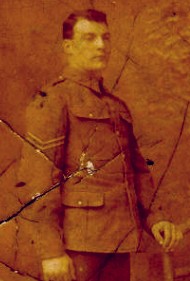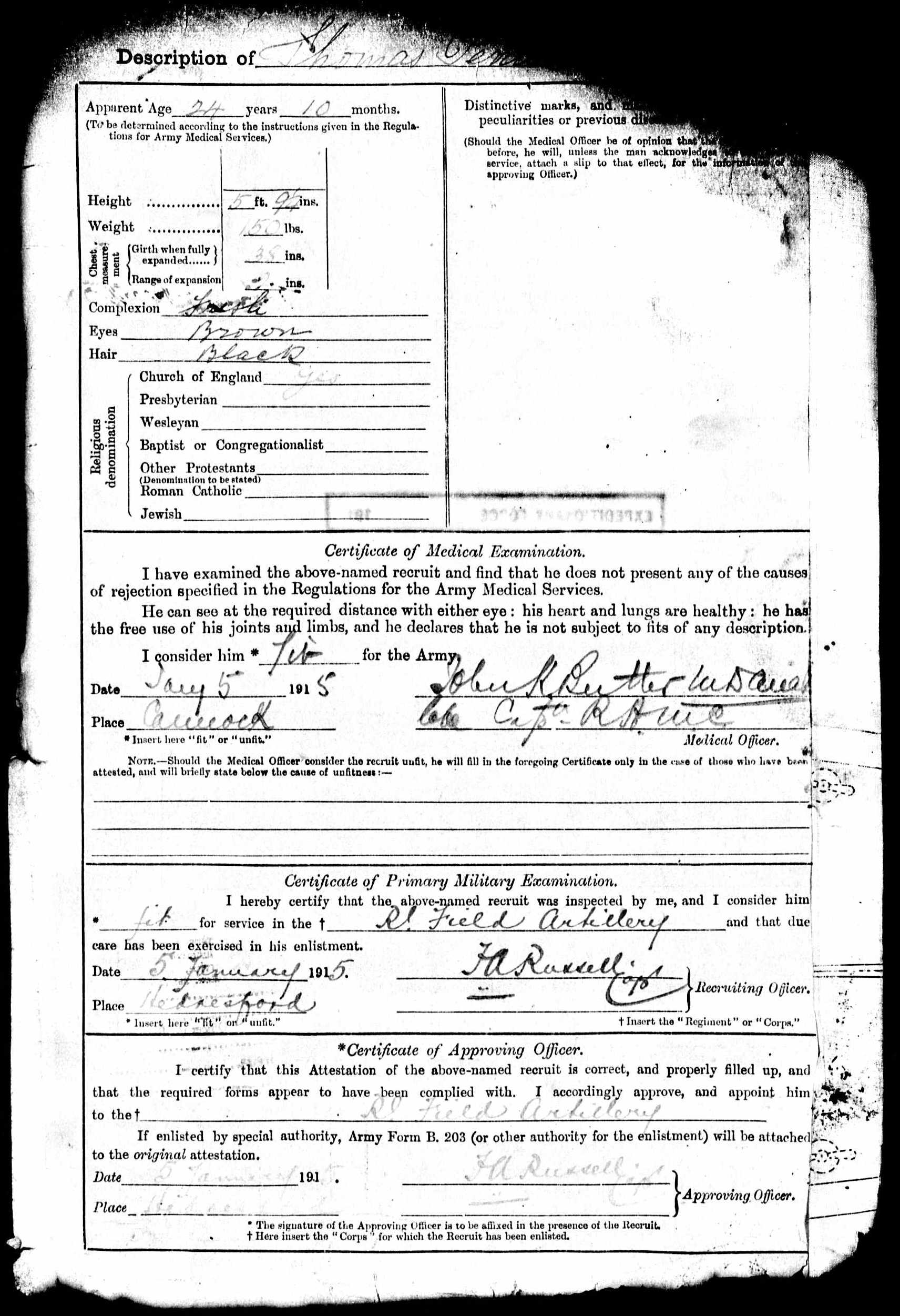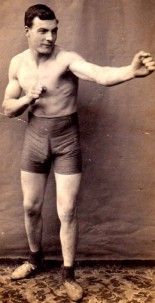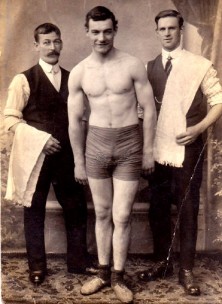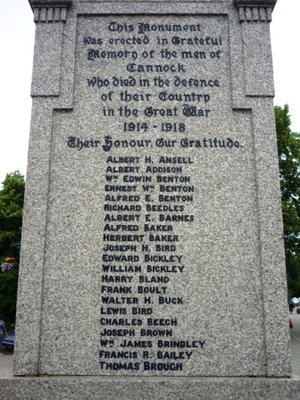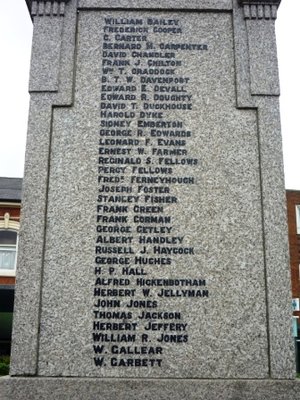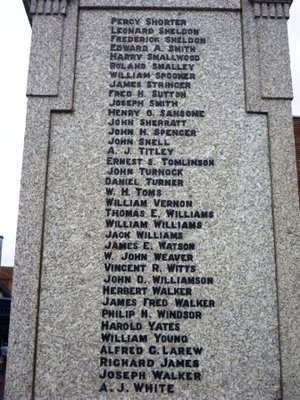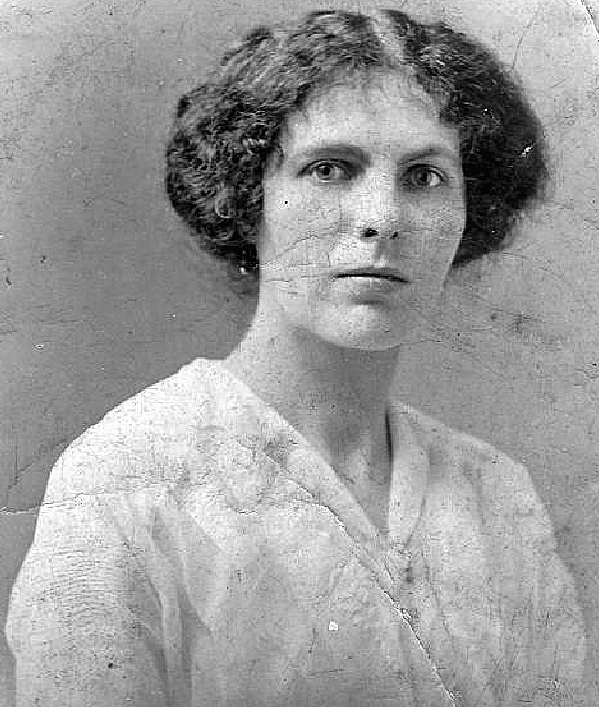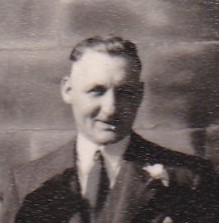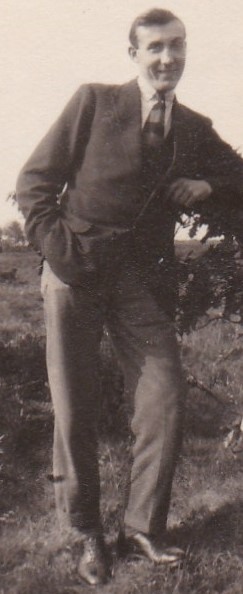The Penton Brothers of Norton Canes
Thomas Penton 1889 - 1979
James Penton 1894 - 1916
Harry Penton 1896 - 1978
Researched and written by Mike INSKIP, Alan BETTS and Chris GRADDON
The three older brothers from this Norton Canes mining family all served in the British Army in World War 1.
Harry Penton is Mike Inskip's grandfather. ‘Uncle Tom’ & ‘Uncle Jim Penton’ are his great uncles.
Here is their census record from 1901:
Exreact from the 1901 census
Picture 1
Transcription of the extract from the 1901 census
Item 2
All three brothers were baptised at Norton Canes Primitive Methodist Church and attended Norton Canes Boys School.
By 1911 the family had moved to Cannock. The three brothers all worked in local coal mines.
Here is their census record from 1911
Extract from the 1911 census
Picture 3
Transcription of the 1911 census
Item 4
All 3 brothers volunteered to join the Territorial Force in 1914 and to serve overseas.
TOM
The oldest brother Tom survived the war but was seriously injured on 2 occasions – firstly by shrapnel from an exploding shell and secondly by mustard gas.
JIM
The middle brother Jim was shot dead at the age of 20 by a sniper just 3 months after arriving in France.
HARRY
The youngest brother Harry served through the whole war as a ‘Driver’. The rank of Driver was given to soldiers responsible for transporting supplies to the front lines and wounded men back from the lines. They used large draught or dray horses to pull wagons in columns. The Driver would usually ride one of the horses. It was a very dangerous job. Such columns were frequently targeted by enemy artillery and machine gun fire.
Harry suffered from episodes of anxiety for the rest of his life.
Here are their military records:
Thomas (Tom) Penton born 1889 Norton Canes
Thomas PENTON was born in 1889 in Norton Canes, Staffordshire, and was the second child and eldest son of 11 children (5 boys and 6 girls) born to parents Thomas and Sarah Alice Penton (née Barker). His birth was registered at Cannock Registry Office in the second quarter of 1889 and he attended Norton Canes Boys School
By the time of the 1911 census on 2 April, Thomas was living with his parents and seven siblings at 27 St Johns Road Cannock. He was aged 22, single and working at a local coal mine as a loader underground. His father and two of his younger brothers James and Harry were also miners but it is not known if they all worked at the same mine.
With the onset of the First World War, Thomas signed up for the Army. His younger brothers had already enlisted, Harry in 1913, aged just 17, and James in September 1914, aged 23. Thomas was still working as a miner when he was examined on 4 January 1915. He was 24 years 10 months old, 5 feet 9 inches tall and weighed 150 pounds; he had a good physique and had a scar on his right cheek which he received in infancy.
He passed the medical examination, and enlisted the following day at Hednesford, Staffordshire. Thomas joined the Royal Field Artillery with regimental number 31933. He was a Gunner and then a Lance Bombardier. He entered the theatre of war in France on the 29 July 1915.
Thomas first saw action near Armentieres. His brother Harry had been sent there five months earlier in February. He was only there for a short time before being sent to the Somme, where he served in the attack of July 1916. Whilst serving on the Somme, he was sent to fight at Bienvilliers. It was there, on 6 November 1916, that Thomas received a shell wound to his left arm, fracturing his radius and ulna. He was bought home to England and, on 11 November, he was admitted to the Huddersfield War Hospital. He was found to have fractures to both his radius and ulna’. He stayed in hospital until 5 January the following year, 1917.
Once fit for action, Thomas returned to the theatre of war in May 1917 and found himself in France at Langemark. Six months later on 3rd November, he was gassed. Again he was returned to England, and on 11 November (12 months to the day) he was admitted to the East Sussex Hospital in Hastings suffering from gas burns. On 29 November he had a hernia operation. He stayed in the East Sussex Hospital until 12 February 1918 when he was transferred to the Summerdown Camp Military Convalescent Hospital near Eastbourne. He left there on 16 March 1918.
Following his treatment, Thomas was assessed as being permanently unfit for any further service and transferred to the Class "P" Army Reserves ("men whose services are deemed to be temporarily of more value to the country in civil life rather than in the Army") - though he continued to receive army pay. By this time, Thomas had married Marie Griffiths and they were living at 68 Wolverhampton Road, Cannock. His employer's address was given then as Wimblebury Colliery near Hednesford. Thomas was discharged on 24 January 1919 when his home address was 31 Old Penkridge Road, Cannock.
Thomas was awarded the 1914-1915 Star, the British War Medal and the Victory Medal.
1914-1915 Star, British War Medal and Victory Medal
Picture 5
Photograph of Thomas Penton
Picture 6
Picture 8
Picture 7
Thomas Penton
Served in Royal Field Artillery
Rank – Gunner then Lance Bombardier
Regimental No 31933
Theatre of War – France
Date of Entry therein – 29 July 1915
Thomas Penton Medical Record
6 November 1916 SW (shell wound) Left arm
Admitted Huddersfield War Hospital 11 November 1916 to 5 January 1917 ‘fracture Left radius/ulna’
3 November 1917 Gassed
Admitted East Sussex Hospital, Hastings 11 November 1917 to 29 November 1917 ‘gas burns’
Admitted Hastings Hospital 29 November 1917 to 12 February 1918 ‘gas burns & op. for hernia’
Admitted Military Camp Hospital Eastbourne 12 February 1918 to 16 March 1918 ‘gas burns & op. for hernia’
Records at Walsall Hospital May 1919, 27 May 1920, 7 July 1921 & 15July 1921 (? as an outpatient)
Thomas Penton was awarded 1914-1915 Star, British War Medal 1914-1920 & The Victory Medal
Medal Card for Lance Bombardier Thomas Penton’s medal card © Ancestry
Picture 9
Extract for Thomas Penton from Walsall and District The Roll of the Great War 1914 - 1918
Picture 10
Signed receipt for Thomas Penton’s Victory Medal
Picture 11
Pictures 12 - 18
Extracts from Thomas Penton's military records
Picture 19
Extract from Thomas Penton's military pension record
Pictures 20 & 21
Extracts from Thomas Penton's military medical records
Pictures 22 and 23
Boxing photos of Tom Penton. The identities of the two 'seconds' are not known.
James (Jim) Penton
James Penton was born on 21 November 1894 in Norton Canes, Staffordshire, and was the second eldest son of 11 children (5 boys and 6 girls) born to parents Thomas Penton and Sarah Alice Penton (née Barker). James was baptised at the Trinity (Primitive) Methodist Church in Norton Canes on 20 December 1894 and his birth was registered at Cannock Register Office in the first quarter of 1895. Like his elder brother, James attended Norton Canes Boys School.
By the time of the 1911 census on 2 April, James was living with his parents and seven siblings at 27 St Johns Road Cannock. He was aged 17, single and working at a local coal mine as a trammer underground (the trammer's job was to load the coal into the coal trucks, or "trams", each of which would contain about 9 hundredweight of coal). James' father and two of his brothers Thomas and Harry also worked in the coal mine.
As he grew up, James took an interest in boxing, and had a promising career ahead of him but, with the onset of the First World War, he signed up for the Army. James' younger brother, Harry, had enlisted for the army in 1913, aged just 17, and his elder brother Thomas enlisted in 1915 at the age of 24. James was still working as a miner when he was medically examined. He enlisted at Hednesford on the 2nd September 1914 and joined the Prince of Wales’s Volunteers (8th Battalion South Lancashire Regiment) as Private 15298.
The 8th Battalion was formed in Warrington in September 1914 and attached to the 75th Brigade, 25th Division. Units were assembled around Salisbury in September 1914 and then moved to Aldershot in May 1915 for final training. The 8th Battalion crossed to France between 25 and 30 September and was deployed around the area of Nieppe (now on the Franco Belgian border.
James was sent to Bournemouth for his training. Whilst there, he continued his boxing, and fought many fights and won several Open Boxing Competitions, including Cup and Gold Medal.
James was sent to Armentieres, France, and disembarked there on the 28 September 1915. Just after three months into his posting, he was serving in Ploegsteert Wood. On the 14 January 1916 James was shot and killed by a sniper. He was aged 22.
James was buried at Rifle House Cemetery III. B. 4., Comines-Warneton, Hainaut, South Western Belgium. There are 228 servicemen buried in the cemetery, which lies between Messines and Ypres. James was posthumously awarded the 1914-1915 Star, the British War Medal and the Victory Medal.
1914-1915 Star, British War Medal and Victory Medal
Picture 24
Boxing photograph of James Penton
Picture 25
Jim Penton was a talented boxer who won several medals and cups during his military training in Bournemouth prior to being sent to France. This photograph shows his long reach.
Pictures 26 and 27
(Digitally enhanced) Boxing Photograph of James Penton
Boxing photograph of James Penton, seated, with his elder brother Tom Penton and (probably) his younger brother Charles Penton standing behind
It is thought that this group photograph shows Jim Penton seated in the foreground with his elder brother Tom Penton, smoking a pipe, and his younger brother Charles Penton, smoking a cigarette, standing behind him.
Record of death in action of James Penton
Item 28
James Penton served in South Lancashire Regiment ‘Prince of Wales Volunteers’ 8th Battalion.
Rank – Private
Regimental No. 15298
Theatre of War first served in – France
Date of Entry therein -28 September 1915
Killed in action 14 January 1916
James Penton was awarded 1914-1915 Star, British War Medal 1914 -1920 & The Victory Medal (posthumously)
Historical Note
The 8th Battalion was formed in Warrington in September 1914 and attached to the 75th Brigade, 25th Division. Units were assembled around Salisbury in September 1914 and then moved to Aldershot in May 1915 for final training. The 8th Battalion crossed to France 25 -30 September and was deployed around the area of Nieppe (now on the Franco Belgian border).
James Penton's grave is at Rifle House Cemetery, Comines-Warneton, Hainaut, south western Belgium between Messines & Ypres where there are 228 graves. The grade reference is III.B,4I
Picture 29
Rifle House military cemetery, Comines-Warneton, Hainaut, Belgium
Picture 30
Rifle House military cemetery, Comines-Warneton, Hainaut, Belgium
Picture 31
Grave of 15298 Private James Penton, Rifle House military cemetery, Belgium
Picture 32
Plan of Rifle House Cemetery showing the location of the grave of James Penton
Picture 33
Annette Martin (née Leighton) – the daughter of James Penton Leighton, granddaughter of the Penton brothers' sister Alice Penton (born 1892) – laying a wreath on the grave of Jim Penton in 2010.
Picture 34
Private James Penton’s medal card
Picture 35
Pictures 36 and 37
Photograph of Private James Penton from the Walsall Observer, 29 January 1916
Article about the death of Private James Penton from the Walsall Observer, 29 January 1916
Pictures 38 and 39
Memorial plaque at the Church of St James the Great, Norton Canes.
The plaque, which includes James Penton, was erected by past and present scholars of the Norton Canes Boys School and a few friends in July 1919.
Memorial Plaque at Trinity Methodist Church, Norton Canes
Picture 40
Photograph of Norton Canes Boys’ School Roll of Honour
Picture 41
Names on Norton Canes Boys’ School Roll of Honour
Item 42
Article about the death of Jim Penton from the 22 January 1916 Cannock Advertiser
Picture 43
Jim Penton's name is recorded on the Cannock Market Place War Memorial
Cannock Market Place War Memorial
Picture 44
Pictures 45, 46, 47 and 48
The panels on Cannock Market Place War Memorial
Item 49
The names inscribed on the panels of Cannock Market Place War Memorial
Commonwealth War Graves Commission Certificate in memory of James Penton
Picture 50
Harry Penton
Harry Penton was born in Norton Canes, Staffordshire on 4 July 1896 and was the third eldest son of 11 children (5 boys and 6 girls) born to parents Thomas Penton and Sarah Alice Penton (née Barker). Harry was baptised at the Trinity (Primitive) Methodist Church in Norton Canes on 30 July 1896 and his birth was registered at Cannock Register Office in the third quarter of 1896. Like his elder brothers, Harry attended Norton Canes Boys School.
By the time of the 1911 census on 2 April, Harry was living with his parents and seven siblings at 27 St Johns Road Cannock. He was aged 15, single and working down the mine as a motor bay driver. His father and two of his younger brothers James and Harry were also miners but it is not known if they all worked at the same mine.
Harry was the first of his family to enlist in the Army, signing up in 1913 prior to the onset of the First World War. His older brother James enlisted the following year, 1914, aged 23, and Thomas his eldest brother enlisted in 1915 aged 24. Harry was still working in the mine when he signed up, aged just 17. He passed the medical examination and enlisted at Hednesford, Staffordshire with the Territorial Force on the 10th February 1913. His regimental number was 1362, then 991 and then 31933.
Harry served as a Driver (number 1362) in the Royal Engineers 2nd North Midland Field Company. Each Driver (equivalent in rank to Private) looked after 2 horses. They would usually join up with 2 other drivers to form a 6 horse team which pulled a wagon. When war started, this was the main transport to and from the front. Drivers took arms, food and medical supplies to the front and brought casualties back from the lines. They would also pull heavier artillery into position at times. Drivers were also often trained as gunners so they could relieve other gunners at times. The wagons would frequently be targeted by enemy machine gun fire and artillery in an attempt to disrupt supply lines to the front line troops. The carnage of dead and maimed horses and men was not uncommon.
Like both his brothers, following training Harry was sent to France. He arrived there on the 28th February 1915, going straight into action at Armentieres. His eldest brother Thomas followed him to Armentieres five months later, in July.
Harry was only there for a short time before moving on to Neuville-Saint-Vaast, and from there he moved on to Abbeville in December 1915. He returned to the Pas-de-Calais department in March 1916 and was billeted at Mont-Saint-Éloi. That year, he took part in the battle of the Somme, and was with his Division throughout engagements up until September 1918, when he fell sick.
It is quite possible that, like so many survivors of this conflict, Harry suffered from “shell shock”, a severe anxiety disorder associated with active military service. We might now use the term “post traumatic stress disorder”. Despite a number of military hospitals being given over to treating this disorder during 1917, "shell shock" was entirely banned as a diagnosis in the British Army and mentions of it were censored, even in medical journals. There was a tremendous stigma attached to the diagnosis at the time. Many regarded it as “showing a lack of moral fibre” or “weakness of character”. It would not be something to ever be discussed or have written in any records.
Harry's experiences during the Somme campaign, together with the death of his brother James on 14 January 1916 and the severe injuries and gassing of his brother Thomas, would have been bitter experiences for a young man. Nevertheless, he taught himself quite passable French whilst over there and he was undoubtedly an intelligent man. However, at that time, educational opportunities were severely limited for someone from his mining background so he was never able to achieve this potential. Had he been born 60 years later it is very likely that he would have been university educated and entered a profession. Although Harry never talked about his experiences during the war, he did sometimes show his grandson Mike Inskip photographs of himself with his horses in France.
Harry was returned to England and recuperated in Wellington. He was assigned, nominally, to the Corps Royal Engineers 20th Territorial Force Depot - an administrative facility for home based sick and wounded R.E. servicemen. The role of the Territorial Force Depots seems to have been purely administrative, typically with a strength of about 1 officer and 10 other ranks or so. However, they appear to have had a large number of men "on their books" who were not actually present but who were in hospital or at home recuperating. Many of these men would later be discharged wounded. The 20th Territorial Force Depot was an administrative centre based at Pier Road, Gillingham, Kent. They had about seven companies throughout Kent and administered the following units:
4th Home Counties(Howitzer) Brigade, R.F.A.
Home Counties Heavy Battery, R.G.A.
Kent (Fortress) R.G.A.
Kent (Fortress) R.E whose HQ was at Chatham
Fortress Companies were formed for home defence duties and were converted to Field Companies for overseas service.
Following his recovery, Harry was discharged from the Army on 16 July 1919, under Paragraph 392 (xvi), Kings Regulations – which declared that he was "no longer physically fit for war service".
Like his two elder brothers, Tom and Jim, Harry received the 1915 Star Medal, the British War Medal 1914 -1920 and the Victory Medal.
1914-1915 Star, British War Medal and Victory Medal
Picture 51
Harry's family still have his war medals.
Harry Penton's War Record
Enlistment 10 Februarty 1913
Signed up with the Territorial Force in February 1913, Walsall Road Cannock - gave his age as 17
Served in Royal Engineers 2nd North Midland Division, Rank - Driver
Regimental No. 991, 488045
Theatre of War first served in - France
Date of entry therein - 28 February 1915
Discharged 16July 1919
Corps RE 20th T.F.DEP
Cause of Discharge – PARA392(xvi) Kings Regulations – ‘no longer physically fit for war service’
Received 1914-1915 Star, British War Medal 1914 -1920 & the Victory Medal
Photograph of Harry Penton
Picture 52
Harry Penton mounted on a dray horse
Picture 53
Medal card for Harry Penton
Picture 54
Medal card for Harry Penton
Picture 55
Picture 57
Picture 56
Driver Harry Penton
Picture 58
The family of Thomas, James and Harry Penton
Their parents Thomas Penton and Sarah Alice Barker were married on 26 July 1886 at the Parish Church of St James the Great in Norton Canes. Thomas was a bachelor aged 23, a miner from Norton Canes, and was the son of Thomas Penton who was also a miner. Sarah was also aged 23, a spinster from Norton Canes, and was the daughter of Thomas Davies who was also a miner. They were married by the curate Walter William Boulton in the presence of John Penton and Eliza Ann Penton.
Picture 59
Picture 60
In 1901 the family lived on Brownhills Road in Norton Canes but by 1911 the family had moved and were living at 27 St John's Road, Cannock. The brothers' father, Thomas Penton, was working in the mines above ground as a colliery check weighman. He was born in Brownhills about 1863, and the brothers' mother Sarah Alice Penton was born in West Bromwich, also about 1863. Together the couple had 11 children and, unusually for a mining family at the turn of the century, all 11 survived from infancy into adulthood. They had 6 daughters - Emily, Alice, Fanny, Gertrude, Florence and Beatrice - and 5 sons - Thomas, James, Harry, Charles and Edward.
At the time of the 1891 census, the family were living on Norton East Road in Norton Canes.
Extract from the 1891 census
Picture 61
THE SIX DAUGHTERS
Emily ‘Em’ Penton
The oldest child Emily 'Em' Penton was born in Norton Canes on 25 May 1887 and her birth was registered in Cannock between July and September 1887. She was baptised at the Trinity (Primitive) Methodist Church in Norton Canes on 19 June 1887.
The 1911 census shows her working as a servant to 91year old Ann Arnoth How and her 37 year old granddaughter Jessie Kate Smith at Tyrol House, Holywell Road, Malvern Wells.
At the age of 35 she married John ‘Jack' M Billingsley in the third quarter of 1922 in Toxteth Park Lancs. His family owned a silk shop in London. They had a daughter Sheila Mary Billingsley, birth registered in the second quarter of 1926 in Paddington. Jack died in the second quarter of 1931 in Southwark at the age of 37 when Sheila was 5.
Emily went on to marry Frederick Wilson -Temple in the second quarter of 1932 in Kingston. Frederick was a freelance journalist and advertising manager for several periodicals and later a tourist guide. He was a Labour party candidate for the staunchly Conservative constituency of Spelthorne in south west London contesting the general elections in 1924, 1929, 1931 and 1950. In 1950 he came within 31 votes of the winning Conservative candidate but was never elected to parliament. They lived in Bushy Park London and later St Thomas’s Mansions in the 1950s. Frederick died in the second quarter of 1959, aged 73. Emily outlived him and eventually lived with her younger sister Fanny in Walton on Thames till her death .
Picture 63
Picture 62
Alice Penton
Alice Penton, was born in Norton Canes on 7 May 1891. She was baptised at the Norton East (Primitive) Methodist Church in Norton Canes on 7 June 1891. Between October and December 1910 she married Eli John Leighton at the Cannock Register Office. He was a coal miner and had been born in Hednesford in 1888.
Eli John Leighton and Alice Penton in 1910
Picture 64
Alice's husband, Eli John Leighton, served as a Farrier in the Staffordshire Yeomanry in World War 1. He died in the Cannock area in 1966 at the age of 78.
Photograph of Eli John Leighton
Picture 65
Article in the 29 January 1916 edition of the Cannock Advertiser about Thomas, James and Harry Penton and their brother-in law Eli John Leighton
Picture 66
Pictures 67, 68, 69 and 70
Alice died in South Staffordshire on 28 December 1992 at the age of 101.
Alice Penton
Picture 71
Frances 'Fanny' Penton
Thomas and Sarah Alice Penton's third daughter, Fanny Penton, was born Norton Canes and her birth was registered in Cannock between April and June 1893. She was baptised at the Norton East (Primitive) Methodist Church in Norton Canes on 2 May 1893. She worked in Paris as a governess till the German invasion in 1940. She then moved back to live with her elder sister Emily in London for a while before retiring to Walton on Thames. She never married.
Frances 'Fanny' Penton taken about 1926 on the Avenue de Bois in Paris
Picture 72
Frances 'Fanny' Penton on the Rue Dumont d'Urville, Paris in 1938
Picture 73
Mary Gertrude ‘Gertie' Penton
Picture 75
Picture 74
Tom and Sarah's fourth daughter Mary Gertrude 'Gertie' Penton, was born on 16 May 1898 in Norton Canes. She was baptised at the Norton East (Primitive) Methodist Church in Norton Canes on 11 June 1898. She married Herbert C ' Burt' Peacock in Hartlepool, County Durham, between January and March 1930. Burt was a Birmingham tram driver when they married. Later he became a designer for Stanley pipes. The couple had two children. Gertie died in Nottinghamshire in 1984 at the age of 86.
Mary Gertrude ‘Gertie' Penton with her younger brother Edward 'Ted' Penton
Picture 76
Florence 'Florie' Penton
Florence 'Florie' Penton (standing) with her younger sister Beatrice
Picture 77
Fifth daughter, Florence 'Florie' Penton, was born in Norton Canes and her birth was registered in Cannock between January and March 1903. She married Richard Henry 'Harry' Cliff, a coal miner, at St Luke's Church in Cannock on 8 June 1924. The couple had two daughters. Florence died aged 60 in 1963.
Florence Cliff, born Florence Penton
Picture 78
Beatrice 'Beaty' Penton
The youngest child of Thomas and Sarah Alice Penton, Beatrice ‘Beaty' Penton, was born in Cannock and her birth was registered in Cannock between July and September 1905. Her mother was then 42 years old.
Florence Penton
Picture 79
Beaty had epilepsy and mental health problems. She lived with her parents in Cannock and after her mother died she became a long term inpatient in the Staffordshire County Asylum at Burntwood (later referred to as St Matthews Hospital ). She died there at the age of 50 in 1955.
The Burntwood Asylum was a huge institution with 1302 beds located between Burntwood and Lichfield and was a community in its own right. It opened in the 1860s and only closed in 1995. It has now been largely demolished and is the site of a new housing estate between Coulter Lane and St Matthews Road.
Picture 81
Picture 80
The Five Brothers
Thomas 'Tom' Penton
Towards the end of the Great War, Tom and Sarah's eldest son Thomas Penton married Marie Griffiths on 8 May 1917 at the Congregational Church in Stafford. Marie was always known as Daisy. Thomas Penton and his wife had 3 children, all born in the Cannock area.
Tom & Marie 'Daisy' Penton
Picture 82
In the photograph of Thomas and Daisy - which was probably taken on their wedding day - Thomas has a single "Wounded Stripe" pinned to his left forearm. By the end of the war, Tom had earned two wounded stripes. The stripe was awarded to British servicemen who were wounded in action and consisted of a brass stripe two inches long with a backing plate that was hidden inside the uniform sleeve.
WW1 British Wounded Stripe
Picture 83
Tom suffered his initial wound, a shell injury to his left arm, in November 1916; he was treated for a fracture to the left radius/ulna in Huddersfield War Hospital from 11 November 1916 to 5 January 1917. He then returned to duty in France, though he did return home to marry Marie Griffiths in May 1917. In November 1917 Tom was gassed - probably with mustard gas (sulphur mustard) - at Langemark, a small village near Ypres in West Flanders, Belgium.
Langemark was notorious in military history as the site where - at the beginning of the Second Battle of Ypres on the Western front in April 1915 - German forces first used poison gas (chlorine). It was in this same area in mid 1917 that mustard gas was first deployed by the German forces. The village was totally obliterated in the fighting and is now the site of a very large German war cemetery. After the war, sulphur mustard was developed as the first chemotherapy agent of the 20th century.
This second wound must have been a far more serious injury for Tom and required treatment at hospitals in Hastings and Eastbourne on the south coast of England until March 1918. He was still receiving treatment at Walsall Hospital for these injuries in 1921 by which time his first two children had been born. One entry in his medical records from Walsall Hospital, dated 27 May 1920, reads "Man states his nerves are bad, is liable to let things fall from his hands in the morning".
James 'Jim' Penton
Sadly, Jim Penton, the second son, died fighting for his country n 1916.
Jim Penton boxing ar Dean Court 20 March 1915
Picture 84
Pictures 85, 86, 87 and 88
Private James Penton front row 4th from right of picture watching the football game between Boscombe and Clapton Orient (now Leyton Orient) on 27 February 1915
Picture 89
Private James Penton (enlargement from the football match)
Picture 90
Harry Penton
The third son, Harry Penton, was born in Norton Canes on 4 July 1896. Apart from his time in the Army, Harry spent his working life as a coal miner at Littleton Colliery in Cannock . The 1911 census records him employed as a ‘motor bay driver underground'.
Harry volunteered for military service, the first of the brothers to do so, and joined the 2nd North Midland Division of the Royal Engineers as a Driver (a rank equivalent to Private). Each Driver looked after 2 horses. They would usually join up with 2 other drivers to form a 6 horse team which pulled a wagon. This was the main transport to and from the front carrying arms, food medical supplies and casualties back from the lines. They would also pull heavier artillery into position at times. Drivers would often also be trained as relief gunners. It was a dangerous job. The wagons would frequently be targeted by enemy machine gun fire and artillery to disrupt supply lines to the front line troops.
Harry Penton returned home from the Great War and, at the age of 27, married Maud Jackson on 25 December 1923 at St Luke's Church in Cannock, Staffordshire. They had four children, three boys and one girl: Harry Penton in 1925, Victor Owen Penton on 8 August 1926, Ronald Trevor Penton in 1928 and Patricia J Penton in 1931. All 4 children were born in the Cannock area but sadly their eldest son Harry died in 1926 and their third son Ronald died in 1930. Victor Penton had no children but in 1983, at the age of 56, he married Violet Lucy Gordon at Cannock Register Office. Victor lived until 1997 and his wife until 2001. Patricia Penton married William K Inskip at St Luke's Church in Cannock in the summer of 1956 and their only son Michael Inskip - the co-author of this biography - was born in Wolverhampton in 1963.
Harry's only daughter, Patricia Joyce Penton
Picture 91
Photograph of the 'Churchwarden' Clay Pipe Club, taken at the Yew Tree Inn, Mill Street Cannock. Harry Penton is on the extreme right.
Picture 92
In 1978, at the age of 82, Michael's grandfather Harry Penton was taken ill and admitted to Kingsmead Hospital, Cannock, where he died on 29 July of that year. His wife Maud died two years later on 7 March 1980 at Stafford Hospital.
Harry Penton and his Alsatian dog 'Peg' in Cannock Town Centre in the 1950s
Picture 93
The photograph shows Harry Penton and his Alsation ‘Peg’ in Cannock Town Centre in the mid 1950s. The name of his brother, Jim Penotn, is inscribed on the Cannock War Memorial in the background. Peg was one of a long line of unruly canines to inhabit Harry and Maud's small house at 61 Newhall Street. Harry worked at Littleton Colliery until his retiringement at age 65 in 1961. Harry Penton died in Kingsmead Hospital Stafford on 2th July 1978 aged 82. His wife Maud died two years later on 7 March 1980 at Stafford Hospital and his daughter Patricia died in 2008 in Australia at the age of 77.
Charles 'Charlie' Penton
Charles Penton, the fourth son of Thomas and Sarah Alice Penton, was born on 15 October 1899 in Norton Canes and he was baptised at the Norton East (Primitive) Methodist Church in Norton Canes on 26 November 1899. He worked as a coal miner in Cannock all his working life.
Picture 94
Picture 95
Charlie married Florence Maud Gill in a civil ceremony at Cannock between July and September 1920. They had 3 children:
Stanley Charles ‘Stan’ Penton was born on 14th February 1921 (though the birth was not registered until 1935). Stan served in North Africa in World war 2 and was wounded by a land mine. He needed periodic medical treatment for shrapnel injuries for a long time after the war. His memories of the Battle of Wadi Akarit are detailed in a book by B.S. Barnes entitled 'Operation Scipio' which is available from Navy & Military Press. Charles married Vera May Sophia Smith at St Luke's Church in Cannock on 15 February 1947. Stan & Vera had one son Christopher ‘Chris' Penton born 17th April 1956. Stan died in 2000 aged 79.
James Henry ‘Jim’ Penton was born on 21 May 1923. He married Grace Gardner in 1944. They had one son Keith Charles Penton born in 1955. Jim died in 1998 aged 65.
Daisy I Penton was born in 1926 and married John ‘Jack’ Brough at St Luke's Church in Cannock in 1952. They later lived in Wood Lane, Wedges Mills, Cannock. Daisy and her husband Jack had one son, John Sheldon Brough, born in 1956.
The wedding of John ‘Jack’ Brough & Daisy Iris Penton in 1952. Daisy's father, Charlie Penton is standing next to the bride. Her brother, James Henry ‘Jim’ Penton was best man and is standing next to the groom.
Picture 96
In the 1960s Charlie Penton went to live with his daughter Daisy & son in law Jack Brough in Wood Lane, Wedges Mills, Cannock. In his later years, Charlie lived alone in a house opposite Littleton Colliery on Stafford Road, Cannock. Charlie died at the age of 88 in 1988.
Albert Edward 'Ted' Penton
Thomas and Sarah Penton's youngest son, Albert Edward 'Ted' Penton, was born in Cannock on 27 August 1901 and he was baptised at the Norton East (Primitive) Methodist Church in Norton Canes on 1 October 1901. Ted Penton married Ruth Wilkes at St Luke's Church, Cannock on 31 March 1929. Ted and Ruth had one daughter, June Penton, who was born in Cannock between April and June 1930. The family lived in Broad Street, Bridgtown, Cannock.
June Penton never married. She is still living in the Cannock area and supplied many of the family photographs included here. June communicated throughout her life with her unmarried aunt Frances 'Fanny' Penton.
Ted died in the early months of 1976.
Picture 97
Picture 98
Picture 99
Ted Penton (right) with Charlie's son Stan Penton at Ted’s home, 25 Broad Street, Bridgtown Cannock, in 1947
Picture 100
Thomas, James and Harry's mother Sarah Alice Penton died in Cannock at the age of 77 between July and September 1939. Their father, Thomas Penton, died in Cannock at the age of 78 in the early part of 1942.
Picture 101
The photograph above shows their father Thomas Penton (furthest on the right) with two of his sons; Harry Penton is standing by his father's side next to Thomas' youngest son Albert Edward "Ted" Penton. The identities of the 2 other men (the man with the pipe and the man squatting) are not known. It is thought that the photo may have been taken in the late 1920s or early 1930s.
Further information about the Penton family can be found using the links below:
The Eleven Children of Thomas and Sarah Alice Penton (part 1)
The Eleven Children of Thomas and Sarah Alice Penton (part 2)
The Eleven Children of Thomas and Sarah Alice Penton (part 3)
The Eleven Children of Thomas and Sarah Alice Penton (part 4)
Beatrice Penton and the Burntwood Asylum
These comprehensive histories of the 11 children of Thomas and Sarah Alice Penton were compiled and are curated by Dr Michael Inskip, grandson of Harry Penton born 1896. Michael Inskip lives in Victoria, Australia.
Particular mention must also be made of June Penton’s contribution. She provided a large number of the photographs, all meticulously labelled and identified. Sadly, June died recently at the age of 95. She was a thorough and careful family historian and her research has enabled the generations presented here to be remembered for years to come. June will be sorely missed.
June Penton (1930 - 2025)
Picture 102
Item, Source and Credit
1. Extract from the 1901 Census © Ancestry
2. Tanscription of the erxtract from the 1901 Census © Ancestry
3. Extract from the 1911 Census © Ancestry
4. Tanscription of the erxtract from the 1911 Census © Ancestry
5. 1914-1915 Star, British War Medal and Victory Medal © Ghillie Mòr website
6. Photograph of Thomas Penton © Bob Leighton
7. Photograph of Thomas Penton © Dr Mike Inskip
8. (Digitally enhanced) photograph of Thomas Penton © Dr Mike Inskip
9 Lance Bombardier Thomas Penton’s medal card © Ancestry
10. Extract for Thomas Penton from Walsall and District The Roll of the Great War 1914 - 1918 © Walsall Local History Centre
11. Signed receipt for Thomas Penton’s Victory Medal © Ancestry
12. Extract 1 from Thomas Penton's military records © Ancestry
13. Extract 2 from Thomas Penton's military records © Ancestry
14. Extract 3 from Thomas Penton's military records © Ancestry
15. Extract 4 from Thomas Penton's military records © Ancestry
16. Extract 5 from Thomas Penton's military records © Ancestry
17. Extract 6 from Thomas Penton's military records © Ancestry
18. Extract 7 from Thomas Penton's military records © Ancestry
19. Extract from Thomas Penton's military pension record © Ancestry
20. Extract 1 from Thomas Penton's military medical records © Ancestry
21. Extract 2 from Thomas Penton's military medical records © Ancestry
22. Boxing photograph of Thomas Penton © Dr Mike Inskip
23. Boxing photograph of Thomas Penton with his seconds © Dr Mike Inskip
24. 1914-1915 Star, British War Medal and Victory Medal © Ghillie Mòr website
25. Boxing photograph of James Penton © David Penton
26. (Digitally enhanced) Boxing Photograph of James Penton © David Penton
27. Boxing Photograph of James Penton, seated, with his elder brother Tom Penton and (probably) his younger brother Charles Penton standing behind © Dr Mike Inskip
28. Record of death in action of James Penton © Ancestry
29. Extract for James Penton from Walsall and District The Roll of the Great War 1914 - 1918 © Walsall Local History Centre
30. Photograph of Rifle House Cemetery © Pierre Vandervelden
31. Photograph of Rifle House Cemetery © Commonwealth War Graves Commission
32. Grave of James Penton © War Graves Photographic Project
33. Pllan of Rifle House Cemetery showing the location of the grave of James Penton © Commonwealth War Graves Commission
34. Photograph of Annette Martin – {granddaughter of the Penton brothers' sister Alice Penton} – laying a wreath on the grave of Jim Penton in 2010 © Dr Mike Inskip
35. Private James Penton’s medal card © Ancestry
36. Photograph of Private James Penton from the Walsall Observer, 29 January 1916 © Walsall Local History Centre
37. Article about the death of Private James Penton from the Walsall Observer, 29 January 1916 © Walsall Local History Centre
38. Memorial plaque from the Church of St James the Great in Norton Canes © Dr Mike Inskip
39. Memorial plaque from the Church of St James the Great in Norton Canes © Mrs Julie Graddon
40. Memorial Plaque © Trinity Methodist Church, Norton Canes, Staffordshire
41. Photograph of Norton Canes Boys’ School Roll of Honour © BFHG (Alan Betts)
42. Names on Norton Canes Boys’ School Roll of Honour © BFHG
43. Article about the death of Private James Penton from the Cannock Advertiser, 22 January 1916 © Cannock Library
44. Cannock War Memorial © Barry Mort
45. First panel on Cannock War Memorial © Burntwood Family History Group (Alan Betts)
46. Second panel on Cannock War Memorial © Burntwood Family History Group (Alan Betts)
47. Third panel on Cannock War Memorial © Burntwood Family History Group (Alan Betts)
48. Fourth panel on Cannock War Memorial © Burntwood Family History Group (Alan Betts)
49. The names on the panels of Cannock War Memorial © Burntwood Family History Group
50. Certificate in memory of James Penton © Commonwealth War Graves Commission
51. 1914-1915 Star, British War Medal and Victory Medal © Ghillie Mòr website
52. Photograph of Harry Penton © Bob Leighton
53. Photograph of Harry PENTON on a dray horse © Bob Leighton
54. Harry Penton’s medal card © Ancestry
55. Harry Penton’s medal card © Ancestry
56. Photograph of the book cover of "The Roll of the Great War" © Walsall Local History Centre
57. Extract for Harry Penton from "The Roll of the Great War" © Walsall Local History Centre
58. Photograph of Harry Penton © Mike INSKIP
59. Photograph of Thomas Penton (born about 1863 in Brownhills) © June Penton
60. Photograph of Sarah Alice Barker (born about 1863 in West Bromwich) © June Penton
61. 1891 Census for Thomas and Sarah Alice Penton and their family © Ancestry
62. Photograph of Emily Penton (born 1887) © June Penton
63. Photograph of Emily Penton and her daughter Sheila Mary © June Penton
64. Photograph of Eli John Leightonand Alice Penton in 1910 © June Penton
65. Photograph of Eli John Leighton from the article in the 29 January 1916 edition of the Cannock Advertiser © Cannock Library
66. Article in the 29 January 1916 edition of the Cannock Advertiser about Thomas, James and Harry Penton and their brother-in law Eli John Leighton © Cannock Library
67. Enlarged photograph of Jim Penton from the article in the 29 January 1916 edition of the Cannock Advertiser © Cannock Library
68. Enlarged photograph of ThomasPenton from the article in the 29 January 1916 edition of the Cannock Advertiser © Cannock Library
69. Enlarged photograph of Harry Penton from the article in the 29 January 1916 edition of the Cannock Advertiser © Cannock Library
70. Enlarged photograph of Eli John Leighton from the article in the 29 January 1916 edition of the Cannock Advertiser © Cannock Library
71. Photograph of Alice Leighton, born Alice Penton © June Penton
72. Frances 'Fanny' Penton taken about 1926 on the Avenue de Bois, Paris © June Penton
73. Frances 'Fanny' Penton on the Rue Dumont d'Urville, Paris in 1938 © June Penton
74. Mary Gertrude 'Gertie' Penton © June Penton
75. Mary Gertrude 'Gertie' Penton © June Penton
76. Mary Gertrude 'Gertie' Penton with her younger brother Edward 'Ted' Penton © June Penton
77. Florence 'Florie' Penton with her younger sister Beatrice Penton © June Penton
78. Florence Cliff, born Florence 'Florie' Penton © June Penton
79. Florence Penton © June Penton
80. Postcard of Burntwood Asylum (St. Matthew's Hospital) © Brownhills Bob website (https://brownhillsbob.com/2011/07/23/6035/)
81. Photograph of the Female Wards of Burntwood Asylum (St. Matthew's Hospital) © Brownhills Bob website (https://brownhillsbob.com/2011/07/23/6035/)
82. Photograph from 1917 of Thomas Penton with his wife Marie ('Daisy') © Dr Mike Inskip
83. Photo of a World War 1 brass "Wounded Stripe" which was awarded to British servicemen who were wounded in action © http://commons.wikimedia.org/wiki/File:Ww1_BritishWoundedStripe.jpg
84. Jim Penton boxing at Dean Court 20 March 1915 © Dr Mike Inskip
85. Jim Penton and his friend Eddie Brown © Dr Mike Inskip
86. Jim Penton, Eddie Brown and two other soldiers © Dr Mike Inskip
87. Jim Penton close-up © Dr Mike Inskip
88. Medal won by Jim Penton in 1915 © Dr Mike Inskip
89. Private James Penton front row 4th from right of picture watching the football game between Boscombe and Clapton Orient (now Leyton Orient) 27 February 1915 © Dr Mike Inskip
90. Private James Penton (enlargement from the football match) © Dr Mike Inskip
91. Patricia Joyce Penton, the only daughter of Harry Penton and his wife Maud © Dr Mike Inskip
92. Photograph of the 'Churchwarden' Clay Pipe Club, taken at the Yew Tree Inn, Mill Street Cannock, with Harry Penton on the extreme right © Dr Mike Inskip
93. Harry Penton and his Alsatian dog 'Peg' in Cannock Town Centre in the 1950s © Dr Mike Inskip
94. Charles 'Charlie' Penton in 1947 © June Penton
95. Charles 'Charlie' Penton in 1952 © June Penton
96. The wedding of John ‘Jack’ Brough & Daisy Iris Penton in 1952 © June Penton
97. Ted Penton © June Penton
98. Ted Pentonin Weston-super=Mare © June Penton
99. Ted Penton with Charlie Penton's son Stan Penton © June Penton
100. Ted Penton with Charlie's son Stan Penton at Ted’s home in 1947 © June Penton
101. Photograph of Thomas Penton (senior) with his sons Harry and Albert Edward Penton © June Penton and Mike Inskip
102. Photograph of June Penton (1930 - 2025) © June Penton and Mike Inskip


